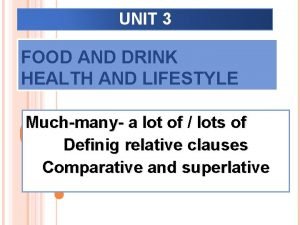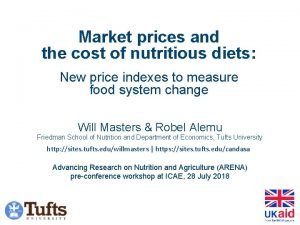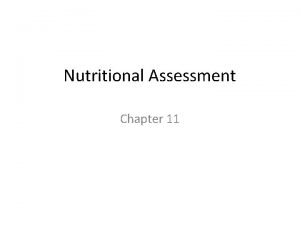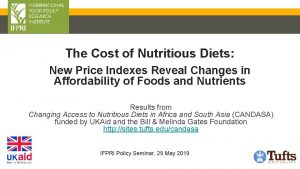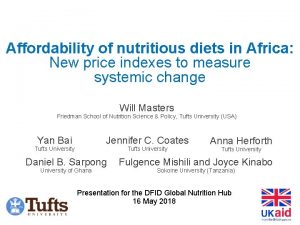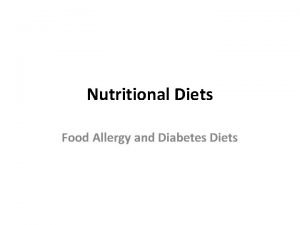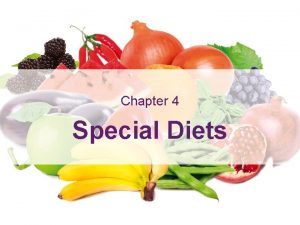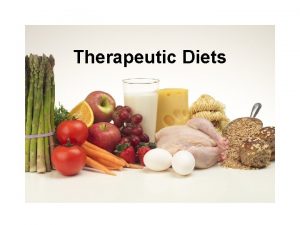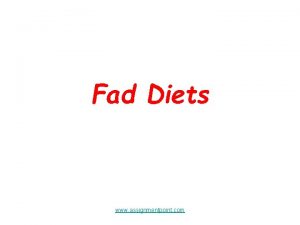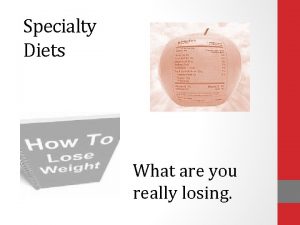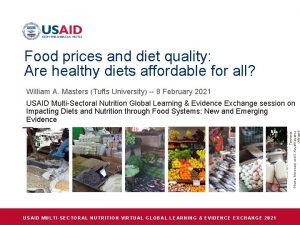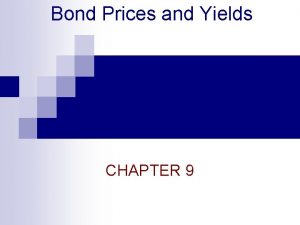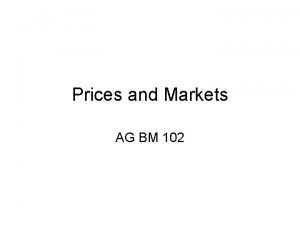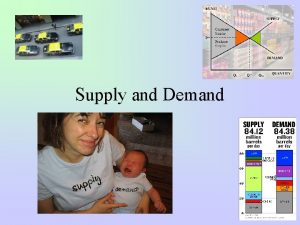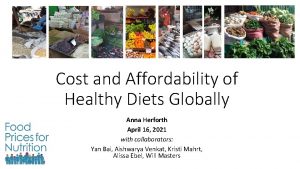Market prices and the cost of nutritious diets






























- Slides: 30

Market prices and the cost of nutritious diets: New price indexes to measure food system change Will Masters & Robel Alemu Friedman School of Nutrition and Department of Economics, Tufts University http: //sites. tufts. edu/willmasters | https: //sites. tufts. edu/candasa Advancing Research on Nutrition and Agriculture (ARENA) pre-conference workshop at ICAE, 28 July 2018

With rapid change in food environments, is the overall cost of nutritious diets easier to buy, or further out of reach?

New price indexes to measure food system change motivation | data | methods & results | use cases & applications | conclusion Existing food price indexes are weighted by market value and say little about nutrition World food commodity prices, 2015 -2018 For global commodity prices, the FAO Food Price Index consists of five commodity group price indices, weighted with average export shares of each of the groups for 2002 -2004. Total of 23 commodities (73 prices), in 5 groups: Source: www. fao. org/worldfoodsituation, 21 July 2018 • Cereals -- wheat (11), maize (1), rice (16) • Oils/Fats -- soybean, sunflower, rapeseed, groundnut, cottonseed, copra, palm kernel, palm, linseed, castor (1 each) • Dairy -- whole milk powder, skim milk powder, cheese (2 each), cheese (1) • Meat -- poultry (13), beef (7), pork (6), sheep (1) • Sugar -- sugar (1)

New price indexes to measure food system change motivation | data | methods & results | use cases & applications | conclusion Measuring diet cost has a long history • For foods actually consumed, a very long history – Fleetwood (1707) food price index = 5 ‘quarters’ of wheat, 4 ‘hogsheads’ of beer – Lowe (1823) different baskets for different socioeconomic groups – Jevons (1865), Laspeyres (1871) and many others lead to modern CPI • For affordability of dietary energy, a long history and wide use – Playfair (1821) chart of wheat prices and wages from 1565 to 1821 – Sukhatme (1961) and FAO’s Prevalence of Undernourishment in calories – Drewnowski (2004) measure of energy cost ($/kcal) and density (kcal/kg) • For nutrient adequacy, more recent history and many specific uses – Stigler (1945) linear programming to compute least-cost diets – USDA Thrifty Food Plan for US nutrition assistance (1975, 1983, 1999, 2006) – SCUK Cost of Diet tool (2009) and FANTA et al. Optifood (2012) for aid programs • For next steps, we introduce three new concepts: – A nutritionally-weight price index (using nutrient profile scores, from 1 to 100) – A cost of diet diversity index (at least one from each of at least 5 food groups) – A cost of recommended diets index (with quantities from local dietary guidelines)

New price indexes to measure food system change motivation | data | methods & results | use cases & applications | conclusion We introduce four kinds of indicators to add up the cost of foods in terms of their nutritional values • Unit-free indexes that track change over time – Nutritious-food Price Index (NPI) • Weight prices by profile scores, instead of expenditure shares as in CPI – Cost of Diet Diversity (Co. DD) • Uses least-cost food from the lowest-cost food groups to reach MDD-W • Cost-per-day values that specify quantities needed – Cost of a Recommended Diet (Co. RD): • weights each price by quantities in the recommended diet – Cost of Nutrient Adequacy (Co. NA): • the least-cost combination of foods to meet nutrient requirements • Applications reveal their advantages and disadvantages for policy analysis, program management, and research

New price indexes to measure food system change motivation | data | methods & results | use cases & applications | conclusion The price of each food depends on where and when it is bought Local food prices in the United States, 1970 -2018 (index values, 1982=100) Retail prices Food away from home (restaurants etc. ) Food at home (groceries) Processed food & feed Wholesale prices Unprocessed food and feed Source: US. Bureau of Labor Statistics, downloaded 21 July 2018. Definitions and chart data are available at http: //myf. red/g/k. Ao. D

New price indexes to measure food system change motivation | data | methods & results | use cases & applications | conclusion Several types of food price data are available • All countries use food prices for their CPI • Many also collect food prices for an MIS • Sources differ in food lists and data quality Market information & price monitoring Ghana Mo. FA enumerator collecting food price data Actor Purpose Agricultural & food agencies Financial & statistical agencies Inform farmers, traders, distributors Measure real income, inflation, poverty Traded commodities, often a few key staple Products foods and cash crops at wholesale markets Photo: Anna Herforth, 2017 National accounts & poverty monitoring Individual prices may be available upon request; Access Private sources charge for subscriptions Retail products, often a long list of over 50 standardized items from urban supermarkets Aggregate indexes reported annually, quarterly or monthly; Item-level prices are sometimes confidential

New price indexes to measure food system change motivation | data | methods & results | use cases & applications | conclusion For nutritious diets, need diverse foods’ prices IANDA (2015 -17) helped Ghana Mo. FA expand price monitoring to more foods Cereals Maize Millet Sorghum Rice White R&T Yam Cocoyam Cassava Gari Sweet potato Cassava dough Dried cassava Meat, Poultry and Fish Beef Pork Salted dried fish Live chicken bird Smoked herring Anchovy Fresh fish Chicken meat Snail Goat meat Mutton Plantain Pulses Plantain Cowpea Soya bean Bambara Vegetables Tomato Garden Egg Okro Onion Ginger Pepper Cabbage Lettuce Carrot Nuts and Seeds DGLV Nkontommire Groundnut (red) Jute mallow Alefu (Amaranthus) Melon Seeds Seed Oil Coconut oil Palm oil Groundnut oil Fruits Egg Dairy Mango Egg Fresh Cow Milk Pineapple Palm fruit Watermelon reports e c i r p t Orange ods marke o f A l F a o n M o i t s e addi Banana Ghana’ h t e d u kets l r c a n i m r n o o j o Coconut will s r 20 ma o f , d e r in Avocado marked Pawpaw

New price indexes to measure food system change motivation | data | methods & results | use cases & applications | conclusion To add up diverse foods, we can use nutrient profile scores (Nu. Val, NRF, SENS etc. ) We can use nutritional value instead of expenditure weights in a CPI • Standard food CPI: – f. CPI = ∑ipiwi , where pi and wi are prices and weights in consumer spending weights each price by quantities actually chosen • Nutritious-food PI (NPI): – NPI = ∑ipini , where ni is a nutrient score, eg Nu. Va. L from 1 (worst) to 100 (best) weighting each expense by its nutritional value § Nutrition scores aim to guide food choices § We use them to measure whether more nutritious foods are becoming more or less affordable

New price indexes to measure food system change motivation | data | methods & results | use cases & applications | conclusion A nutritious-food price index reflects a specific nutrition scoring system Ghana Statistical Service CPI weights (food expenditure shares) versus Nu. Val scores (Nutritional Value index) overty p & e CPI Nu. Val m o c l in a e r u s ) I a e CP weights Used to m is 42% of as a Food (food whole Cereals and cereal products Meat and meat products Fish and sea food Milk, cheese and eggs Fruits Vegetables Oils and fats Sugar, jam, honey, chocolate & confectionery Mineral water, soft drinks, fruit &vegetable juices Food products n. e. c. Non-alcoholic beverages Coffee, tea and cocoa 100 25. 55 9. 10 22. 93 4. 33 4. 29 23. 36 5. 19 2. 29 3. 57 1. 95 5. 57 2. 00 to Could use measure l nutritiona value 100 19. 43 8. 55 14. 12 5. 50 lue > a v l a n o i t i 14. 64 Nutr ding n e p s r e m 32. 67 consu 0. 86 lue < a v l a n o i t i utr ding 0. 24 N n e p s r e m consu 0. 45 2. 50 2. 05

New price indexes to measure food system change motivation | data | methods & results | use cases & applications | conclusion In Ghana, have more nutritious foods become more expensive than other foods? NPI CPI Jul Oct 2017 Apr Apr 2016 Oct Jul Apr 2015 Oct Jul Apr 2014 Oct Jul Apr 2013 Oct Jul Apr 2012 Prices of more nutritious foods rose less than prices of other foods Food Price Indexes in Tamale, 2012 -2017 Source: Author’s calculation, from Ghana Statistical Service file data. Apr 2016 Oct Jul Apr 2015 Oct Jul Apr 2014 Oct Jul . . . but in Tamale from 2012 to 2014, the opposite occurred Apr 2013 CPI Oct Jul NPI Apr 170 160 150 140 130 120 110 100 90 Food Price Indexes in Greater Accra, 2012 -2017 2012 170 160 150 140 130 120 110 100 90

New price indexes to measure food system change motivation | data | methods & results | use cases & applications | conclusion Another metric of diet quality is diversity We follow the MDD-W is defined as ≥ 5 of these 10 food groups in past 24 hrs (1) Starchy staples (Grains, white roots/tubers, plantains) (2) Pulses (beans, peas and lentils – includes soybeans) (3) Nuts and seeds (higher fat than pulses, includes groundnuts) (4) Flesh foods (meat, poultry and fish) (5) Dark green leafy vegetables (6) Other vit. A-rich fruits & vegetables (7) Other vegetables; (8) Other fruits; (9) Eggs; (10) Dairy

New price indexes to measure food system change motivation | data | methods & results | use cases & applications | conclusion We can measure the cost of reaching MDD-W with the least-cost food in each group MDD-W has a direct economic interpretation • • Within groups, all foods are equal substitutes Each group meets different needs, and also contributes to energy balance Groups can be ranked by cost towards total daily energy balance People with at least five groups are likely to reach adequacy thresholds The cost of reaching MDD-W can be defined as: • Cost of Diet Diversity (Co. DD): – Co. DD = Min 5{min{pi 1}, min{pi 2}, …, min{pim}} the least-cost way to include at least one food from at least 5 food groups – Co. DD 2 = Ave{min{pi 1}, min{pi 2}, …, min{pim}} the least-cost way to include at least one food from any 5 of the 10 food groups

New price indexes to measure food system change motivation | data | methods & results | use cases & applications | conclusion The least-cost food in each group may vary Foods counted for the Cost of Diet Diversity (Co. DD) in Ghana, 2009 -14 In Ghana, foods in the five lowestcost groups are: 5. Fish or banana 4. Mangoes 3. Groundnuts 2. Soya 1. Maize or cassava Source: Masters et al. , (2018), “Measuring the Affordability of Nutritious Diets in Africa: Price Indexes for Diet Diversity and the Cost of Nutrient

New price indexes to measure food system change motivation | data | methods & results | use cases & applications | conclusion Each food group may have different trends and fluctuations Foods counted for the Cost of Diet Diversity (Co. DD) in Tanzania, 201115 In Tanzania, each food group varies differently over time 5. Avocado 4. Beef 3. Groundnuts 2. Soya 1. Maize Source: Masters et al. , (2018), “Measuring the Affordability of Nutritious Diets in Africa: Price Indexes for Diet Diversity and the Cost of Nutrient

New price indexes to measure food system change motivation | data | methods & results | use cases & applications | conclusion To measure cost levels (e. g. $/day), we can use the Cost of a Recommended Diet (Co. RD) The previous indexes are unit-free, to measure change over time • Traditional food CPI • Nutritious-food CPI (NPI) • Cost of Diet Diversity (Co. DD) We measure total cost by specifying quantities consumed • Cost of a Recommended Diet (Co. RD): – Co. RD = ∑jpijqj , where pij = min{pij} and qj = requirement for j={1, …, m} categories weights each price by quantities in the recommended diet, lowest-cost only – Co. RD 2 = ∑jpijqj , where pij = median{pij} and qj = requirement for j={1, …, m} categories weights each price by quantities in the recommended diet, all foods equally

New price indexes to measure food system change motivation | data | methods & results | use cases & applications | conclusion The Cost of a Recommended Diet (Co. RD) reflects specific dietary guidelines In Africa, the only countries with dietary guidelines are Benin, Sierra Leone, Nigeria, Namibia, and South Africa (+Kenya soon) Cost per serving for lowest-cost item in each food group (Ghana, 2015) Fruits cify e p ss Vegetables e n i l f e o d Gui umber n Proteins the ings in serv group Starchy staples h eac 0. 00 0. 02 0. 04 0. 06 0. 08 0. 10 Cost/serving (PPP US$/item) Source: Author’s calculation, from Ghana Ministry of Food and Agriculture ot n s ice dairy r p na for Gha ilable ava

New price indexes to measure food system change motivation | data | methods & results | use cases & applications | conclusion The Cost of a Recommended Diet (Co. RD) depends on which foods are used With the median item in each food group (except dairy), total cost would be US$1. 37/day Ghana price data include several high-cost vegetables and protein foods, so those groups can be very expensive Cost per day for a recommended diet, median of all items (Ghana, 2015) Fruits Vegetables Proteins Starchy staples $0. 00 $0. 10 $0. 20 $0. 30 Cost per day (2011 US$ in PPP terms) Source: Author’s calculation, from Ghana Ministry of Food and Agriculture

New price indexes to measure food system change motivation | data | methods & results | use cases & applications | conclusion The Cost of a Recommended Diet (Co. RD) depends on price and quantity per day With the lowest-cost items in each food group (except dairy), total cost would be US$0. 75/day The required portions from each food group cost between $0. 15 and $0. 25 per day Cost per day for a recommended diet, lowest-cost items only (Ghana, 2015) Fruits Vegetables Proteins Starchy staples $0. 00 $0. 10 $0. 20 $0. 30 Cost per day (2011 US$ in PPP terms) Source: Author’s calculation, from Ghana Ministry of Food and Agriculture

New price indexes to measure food system change motivation | data | methods & results | use cases & applications | conclusion The most widely-used gold standard for diet quality remains nutrient adequacy The Cost of Nutrient Adequacy (Co. NA) is a “least-cost diet” using foods that reach EARs at lowest cost: Minimize C = Σipiqi Subject to aij qi > EARj , for j = 1, …, 17 essential nutrients and aie qi = E , for energy where pi is price and qi is quantity of food i, and aij is its content in nutrient j, for which EARj is the Estimated Average Requirements for adult women aged 19 -30, not pregnant or lactating, at 55 kg with energy use (E) of 2000 kcal/day We focus on total cost • Disaggregated by food groups, to show diet composition • Disaggregated by nutrients, valued at their shadow prices

New price indexes to measure food system change motivation | data | methods & results | use cases & applications | conclusion In the Ghana data, vitamin A is very expensive Cost of Nutrient Adequacy (Co. NA) in Ghana, by food group om 2010 to 2014, fr se ro ts n ie tr u n t n ie uying suffic re expensive o m e In Ghana, the cost of b am ec b ) o g an m. -A rich F&V (e. g largely because vitamin Source: Masters et al. , (2018), “Measuring the Affordability of Nutritious Diets in Africa: Price Indexes for Diet Diversity and the Cost of Nutrient

New price indexes to measure food system change motivation | data | methods & results | use cases & applications | conclusion In Ghana, limiting nutrients after vitamin A are energy, calcium, vitamin E & vitamin B 12 Cost of Nutrient Adequacy (Co. NA) in Ghana, by limiting nutrient in A, but m ta vi ly n ai m is n se ri nt whose cost has ie tr u n g in it lim e th a, an In Gh has also risen ts en em ir u q re m iu lc ca the cost of meeting Source: Masters et al. , (2018), “Measuring the Affordability of Nutritious Diets in Africa: Price Indexes for Diet Diversity and the Cost of Nutrient

New price indexes to measure food system change motivation | data | methods & results | use cases & applications | conclusion In the Tanzania data, more different foods sometimes enter the least-cost diet Cost of Nutrient Adequacy (Co. NA) in Tanzania, by food group g 2011 -12, n ri u d A N o C in se ri e som In Tanzania, there was portant roles im g n yi la p s p u ro g d o with many different fo Source: Masters et al. , (2018), “Measuring the Affordability of Nutritious Diets in Africa: Price Indexes for Diet Diversity and the Cost of Nutrient

New price indexes to measure food system change motivation | data | methods & results | use cases & applications | conclusion In Tanzania, limiting nutrients are same as Ghana, plus vitamin C & folate Cost of Nutrient Adequacy (Co. NA) in Tanzania, by limiting nutrient during 2011 -12, A N o C in se ri e m so as In Tanzania, there w iting factors lim as ts n ie tr u n t n re fe with many dif Source: Masters et al. , (2018), “Measuring the Affordability of Nutritious Diets in Africa: Price Indexes for Diet Diversity and the Cost of Nutrient

New price indexes to measure food system change motivation | data | methods & results | use cases & applications | conclusion Application #1: Seasonality in the cost of nutritious diets vs. cost of daily energy Monthly variation in cost of nutrient adequacy vs daily energy in Tanzania, 2011 -15 2011 US dollars per day seasonal Nutrient costs are more transport d an e g ra o st th o b to e du Note: Data shown are coefficient and 95% confidence interval on calendar month indicators, relative to May. Orange bars for cost of calorie adequacy (Co. CA) not significantly different from zero. 25 Source: Bai, Naumova and Masters (2018), Seasonality in Food Prices and the Cost of a Nutritious Diet in Tanzania. Working paper,

New price indexes to measure food system change motivation | data | methods & results | use cases & applications | conclusion Application #1: Seasonality in diet costs can be summarized by a single variable Harmonic regression results for cost of nutrient adequacy in Tanzania, 2011 -15 2011 US cents per day veals both Harmonic regression re of peak costs g in m ti d an e d u it n ag m 26 Source: Bai, Naumova and Masters (2018), Seasonality in Food Prices and the Cost of a Nutritious Diet in Tanzania. Working paper,

New price indexes to measure food system change motivation | data | methods & results | use cases & applications | conclusion Application #2: Ghana’s PFJ program could have more impact if it included F&V Impact on cost of nutrients of 10% price reductions by food group in Ghana, 2011 -15 s) e ric p al ds s d oo e f d nly & se e o c ur s les nuts o a p s c a , al se st ses m y i a h B ul y An ly rc P a l on & les St on s t ui ab Fr get ve In ctu (a e reality, Ghana’s Jobs” “Planting for Food and program excludes fruits and vegetables Source: Sarpong, Bai, Mishili and Masters (2018), Impacts of Agricultural and Trade Policy on the Cost of Nutritious Diets in Ghana and Tanzania. Framework paper for AERC AFPON project, forthcoming.

New price indexes to measure food system change motivation | data | methods & results | use cases & applications | conclusion Application #2: Tanzania’s marketing policies could reduce disparities in cost of nutrients by targeting pulses, nuts & seeds s) Impact on cost of nutrients of 50% s. d. reductions by food group in Tanzania, 2009 -14 e c i r l p a u ct as ca e B (a e s ar St ch t y s s ple o nly a , es ls Pu ly on nu & ts s s d ee ds d ce r ou o fo s & les al s im uit ab An ly Fr get Our on ve whole-of-diet approach ents in reveals how improvem one food group leads other groups straint to become binding con Source: Sarpong, Bai, Mishili and Masters (2018), Impacts of Agricultural and Trade Policy on the Cost of Nutritious Diets in Ghana and Tanzania. Framework paper for AERC AFPON project, forthcoming.

New price indexes to measure food system change motivation | data | methods & results | use cases & applications | conclusion Conclusions and next steps • We provide economic price indexes corresponding to nutritionists’ definitions of a healthy diet: – – Nutrient profile scores for individual foods, modifying CPI to calculate NPI Minimum recommended diets, using dietary guidelines to calculate Co. RD Minimum dietary diversity levels, using MDD-W to calculate Co. DD Minimum (and max. ) nutrient levels, using DRIs to calculate Co. NA • For research, the gold standard remains nutrient adequacy – Initial applications include: • Seasonality in the added cost of nutrient adequacy over daily energy • Policy-induced changes in average levels and also disparities in diet cost • International differences associated with national income and urbanization • For policy and programs, simpler measures are useful too – Ghana Statistical Service (GSS) and Min of Food & Ag (Mo. FA) officials intend to add NPI and Co. RD to their monthly reports

New price indexes to measure food system change motivation | data | methods & results | use cases & applications | conclusion Thank you! The CANDASA project is funded by UKAid and the Bill & Melinda Gates Foundation (OPP 1182628). It is implemented at Tufts and IFPRI in Washington, Delhi and Addis, with academic partners in Ghana, Tanzania, and Malawi, and includes collaborations with ARENA, AFPON, and the ANH Academy. Software tools will be published on the Gates Open Research platform, and also available on the project website at http: //sites. tufts. edu/candasa Special thanks to all price enumerators
 Healthy comparative and superlative adjectives
Healthy comparative and superlative adjectives International market segmentation
International market segmentation Pearson btec health and social care level 3
Pearson btec health and social care level 3 Golden nutritious foods corporation
Golden nutritious foods corporation Real nutritious food menu
Real nutritious food menu Agree or disagree questions about life
Agree or disagree questions about life Nutritious food
Nutritious food Dr richard golden
Dr richard golden Test chapter 11 nutrition and diets
Test chapter 11 nutrition and diets Chapter 11 nutrition and diets key terms
Chapter 11 nutrition and diets key terms Chapter 11 nutrition and diets
Chapter 11 nutrition and diets Define optimal nutritional status
Define optimal nutritional status Market follower
Market follower Diets based on only one basic food element
Diets based on only one basic food element Chapter 11 managing weight and eating behaviors
Chapter 11 managing weight and eating behaviors Fad diets def
Fad diets def Cost accumulation and cost assignment
Cost accumulation and cost assignment Cost accumulation and cost assignment
Cost accumulation and cost assignment Cost accumulation and cost assignment
Cost accumulation and cost assignment Cost accumulation and cost assignment
Cost accumulation and cost assignment Cost control and cost reduction difference
Cost control and cost reduction difference Standard costing process
Standard costing process Distinguish between average cost and marginal cost
Distinguish between average cost and marginal cost Cost control and cost reduction difference
Cost control and cost reduction difference Process and job order operations are similar in that both
Process and job order operations are similar in that both Ordering cost and carrying cost
Ordering cost and carrying cost Trade off and opportunity cost
Trade off and opportunity cost Cost control and cost reduction project report
Cost control and cost reduction project report Cost control and cost reduction project report
Cost control and cost reduction project report Cost structure refers to the relative proportion of
Cost structure refers to the relative proportion of Chapter 6 prices and decision making assessment answers
Chapter 6 prices and decision making assessment answers
